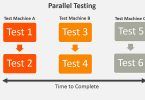Amid the current climate of increasing technology disruption and customer demand, traditional siloed development and operations processes and delivery methodologies are evolving to keep up. One path to that evolution is through Enterprise DevOps, a tenet of the Autonomous Digital Enterprise (ADE), which naturally extends the principles of software DevOps across surrounding business processes to optimize for the rapid and continuous delivery of applications and services.
The ADE framework focuses on the future state of business as companies adopt emerging technologies and automation to not only survive, but thrive, in the face of persistent disruption, which 2020 has certainly delivered. The Enterprise DevOps tenet accelerates that ADE journey, extending agile development processes organization-wide for greater speed and flexibility and a frictionless development environment across both distributed and mainframe systems.
According to the 2019 Accelerate State of DevOps Report, adopting an Enterprise DevOps mindset can help organizations realize significant gains—up to 106x faster commit time from lead to deploy—by applying DevOps principles continuously and comprehensively and enabling end-to-end automation, rapid and frequent releases or improvements, and creative collaboration across the enterprise.
As the DevOps function itself changes, the jobs to support it are changing, too. The DevOps Institute’s Upskilling 2020: Enterprise DevOps Skills Report found that 52 percent of organizations are currently recruiting or planning to recruit DevOps professionals, and process, knowledge, automation, and human/interpersonal capabilities now top the must-have skillset for more than 60 percent of respondents.
How does this expanded vision of DevOps come to life? In our Enterprise DevOps e-book, we look at three business use case that put:
- DevOps Service Management: Effective, seamless development and operations collaboration that integrates key systems of record and innovation—and the people and processes that manage them—can improve visibility and application measurement during production and speed issue resolution.
- Automating Applications from Dev to Ops: Orchestrating and automating application workflows as part of the application itself can ensure they’re built, tested, and deployed with the rest of the application artifacts, streamline development and production, increase profitability and competitiveness, and improve service level agreements (SLAs) and the customer experience.
- DevOps on the Mainframe: Investing in a modern, integrated suite of mainframe development, application visualization, and continuous, automated testing tools can empower developers at every level to make decisions, support mainframe-inclusive DevOps toolchains, and improve productivity and collaboration.
Understanding AIOps in Context with Your Needs
See an error or have a suggestion? Please let us know by emailing blogs@bmc.com.







